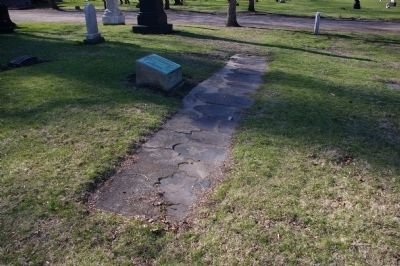Legend of the Land: Erie Street Cemetery
While Erie Street Cemetery is now the oldest existing cemetery in Cleveland, it was not the first. Originally called City Cemetery, it was bought for $1 after Cleveland’s first cemetery, The Ontario Street Cemetery, was bought for new development in a rapidly expanding early Cleveland. Leonard Case bought the 10 acres of land for the Erie Street Cemetery in the hope that it was far enough out of town that it would never need to be relocated again. A quote from Judge Rufus P. Spalding from 1826 reads, “In riding away from Cleveland in the stagecoach I passed the Erie Street Cemetery just then laid out. I recollect it excited my surprise that a site for a burying ground should be selected so far out of town.”
Although far out of town at the time, the property along East 9th Street became more sought after as the city continued to grow and expand. There have been many attempts over the years to build over the cemetery and use the land for other purposes such as space for a streetcar turnaround or to expand the Central Market, which once existed nearby. By the 1860s, all the surrounding lots had been sold and due to the threats of selling the property, many bodies were exhumed and moved to other cemeteries throughout the city.
There are many notable people buried in this cemetery, including many of Cleveland’s mayors, Revolutionary War veterans, and Native American Chiefs. However, this article only touches on three of the many buried in Erie Street Cemetery.
Lorenzo Carter was one of the first permanent settlers of Cleveland. Unhappy with his life as a farmer in Vermont, he decided to venture into the wilderness that was then known as New Connecticut. Carter’s family, along with three others, arrived in Cleveland a year before Moses Cleaveland and suffered through the brutal winter. The Carter gravesite reads “They Remained-Others Fled.” Carter died at the young age of 47 in 1814 but accomplished much in his life. Carter welcomed travelers into his home, launched a ferry across the river to promote trade, and much more. Cleveland was made possible by early pioneers such as The Carters.
One important gravesite in the cemetery is the Case monument. Leonard Case Sr. was the man who purchased the land and then donated it to the city for the purpose of a cemetery. Born in 1786 in Pennsylvania to German migrant parents, he suffered from what is most likely today’s infantile paralysis that left him with crippled limbs. He studied law and passed the bar, at the age of 30 he came to Cleveland to be a cashier at Cleveland’s first bank. In 1832 he became president of the Commercial Bank of Lake Erie. His obituary read, “although crippled and frail since a boy was said to be a giant of civic and business actives of Cleveland”.
Joc-O-Sot, also known as Walking Bear, was the Chief of the Fox (or Mesquakie) Tribe. He fought against the United States and allied with the British in The Black Hawk War of 1832. After a treaty was signed to end the war, Joc-O-Sot came to Cleveland and worked as a hunting and fishing guide. He also joined the Dan Marble theatrical group that toured the U.S. and Europe. After being received by Queen Victoria on a successful European tour in 1844, Joc-O-Soc fell ill from an old war wound. He made his way back to Cleveland to receive medical attention from friend and doctor, Horace A. Ackley, but never reached the doctor’s office and passed on what was called Stockley’s Pier. His gravestone reads, “The Walking bear A Distinguished Sauk Chief”.
The breathtaking Gothic gateway entrance and iron fence were built in 1870, which cost $8,196 at the time. But by the 1920s, the cemetery had fallen into disrepair with the wrought iron fence that once stood protecting the grounds laid on the ground. The cemetery was plagued by theft and vandalism. However, the years 1939 and 1940 proved to be a turning point as they were a time of unprecedented success in the city. In 1940 The Early Settlers Association (ESA) raised $239,000 for cemetery improvements and built a stone wall that replaced the destroyed iron fence. The restoration of the cemetery in 1939 and 1940 by community groups put an end to the suggested selling of the land.
In 1948 the ESA placed a marker in the cemetery in memory of people whose bodies had been moved from Cleveland’s first cemetery, Ontario Street Cemetery. In front of the marker, you can see the “mortuary roll”, the original headstones of people moved from Ontario Street Cemetery laid side-by-side against the ground.
The Mortuary Roll with the original headstones from Ontario Street Cemetery
In 2009 The Ohio Cemetery Alliance, Ohio Historical Society, and ESA erected a historical marker near the Gothic entrance to the cemetery on East 9th Street. In addition, The Cuyahoga Community College (Tri-C) Honors Program undertook a clean-up of the grounds. The Tri-C Honors Program, the Early Settlers Association, and the City of Cleveland continue to seek assistance, programming, and policies to create an educational service regarding its historical significance and provide a learning site in Downtown Cleveland. More recently The Downtown Cleveland Alliance Green Team assisted in clean-up efforts of Erie Cemetery, gathering to pick up litter to maintain and preserve the historical site.






